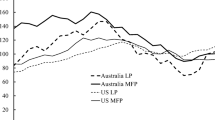Abstract
This chapter presents an exploratory analysis of different stages in the gold production cycle, notably exploration, mining, processing, and refining. It analyzes key technological changes, as well as changes in the constellation of actors involved in each of these stages. This exploratory analysis reveals that gold production is accessible to smaller and less powerful players, including small miners, traders, and refiners. It also reveals linkages that connect these actors to one another, and to larger mining companies and refineries. In many cases, these linkages span across the formal-informal divide. Finally, it draws attention to how both the accessibility of gold production and the linkages between the various actors involved in it are facilitated by the material properties of gold.
Access this chapter
Tax calculation will be finalised at checkout
Purchases are for personal use only
Similar content being viewed by others
References
Albanese, T., & McGagh, J. (2011). SME mining engineering handbook (P. Darling, Ed.) (pp. 21–36). Englewood: SME.
Bloomfield, M. J. (2017). Global production networks and activism: Can activists change mining practices by targeting brands? New Political Economy, 22(6), 727–742.
Bury, J. (2004). Livelihoods in transition: Transnational gold mining operations and local change in Cajamarca, Peru. Geographical Journal, 170(1), 78–91.
Carstens, J., & Hilson, G. (2009). Mining, grievance and conflict in rural Tanzania. International Development Planning Review, 31(3), 301–326.
Darling, P. (2011). Mining: Ancient, modern, and beyond. In P. Darling (Ed.), SME mining engineering handbook (pp. 3–10). Englewood: SME.
Dougherty, M. L. (2013). The global gold mining industry: Materiality, rent-seeking, junior firms and Canadian corporate citizenship. Competition & Change, 17(4), 339–354.
Dougherty, M. L. (2015). By the gun or by the bribe: Firm size, environmental governance and corruption among mining companies in Guatemala (U4 Issue Paper 2015:17). Chr. Michelsen Institute.
Dougherty, M. L. (2016). Scarcity and control: The new extraction and Canada’s mineral resource protection network. In K. Deonandan & M. L. Dougherty (Eds.), Mining in Latin America: Critical approaches to the new extraction (pp. 83–99). Abingdon: Routledge.
Els, F. (2018). The world’s top 10 largest gold mining companies—2017. Retrieved 12 September 2018 from http://www.mining.com/worlds-top-10-largest-gold-mining-companies-2017/.
Ericsson, M. (2012). Mining industry corporate actors analysis (Polinares Working Paper 16). Retrieved 16 May 2019 from http://www.eisourcebook.org/cms/Mining%20industry%20corporate%20actors%20analysis.pdf.
Esdaile, L. J., & Chalker, J. M. (2018). The mercury problem in artisanal and small‐scale gold mining. Chemistry–A European Journal, 24(27), 6905–6916.
Ferry, E. (2016). Gold prices as material-social actors: The case of the London Gold Fix. The Extractive Industries and Society, 3(1), 82–85.
Humphreys, D. (2015). The remaking of the mining industry. Basingstoke: Palgrave Macmillan.
Laha, S. (2014). Informality in e-waste processing: An analysis of the Indian experience. Competition & Change, 18(4), 309–326.
Lepawsky, J. (2015). The changing geography of global trade in electronic discards: Time to rethink the e-waste problem. The Geographical Journal, 181(2), 147–159.
Luning, S. (2014). The future of artisanal miners from a large-scale perspective: From valued pathfinders to disposable illegals? Futures, 62, 67–74.
Mabhena, C. (2012). Mining with a ‘Vuvuzela’: Reconfiguring artisanal mining in Southern Zimbabwe and its implications to rural livelihoods. Journal of Contemporary African Studies, 30(2), 219–233.
Majury, N. (2014). ‘Trusting the numbers’: Mineral prospecting, raising finance and the governance of knowledge. Transactions of the Institute of British Geographers, 39(4), 545–558.
Mooiman, M. B., Sole, K. C., & Dinham, N. (2016). The precious metals industry: Global challenges, responses, and prospects. In R. M. Izatt (Ed.), Metal sustainability: Global challenges, consequences, and prospects (pp. 109–132). Hoboken, NJ: Wiley.
Mwaipopo, R., Mutagwaba, W., Nyange, D., & Fisher, E. (2004). Increasing the contribution of artisanal and small-scale mining to poverty reduction in Tanzania. London: Department for International Development (DFID).
Nelson, M. G. (2011). Evaluation of mining methods and systems. In P. Darling (Ed.), SME mining engineering handbook (pp. 341–348). Englewood: SME.
Ng’Wanakilala, F. (2019). Chinese firms to build gold smelter, refineries in Tanzania. Retrieved 21 November 2019 from https://www.reuters.com/article/tanzania-gold/chinese-firms-to-build-gold-smelter-refineries-in-tanzania-idUSL4N24P3W2.
Patel, K., Rogan, J., Cuba, N., & Bebbington, A. (2016). Evaluating conflict surrounding mineral extraction in Ghana: Assessing the spatial interactions of large and small-scale mining. Extractive Industries and Society, 3(2), 450–463.
Pieth, M. (2019). Gold laundering: The dirty secrets of the gold trade. Zürich: Salis Verlag.
PWC. (2017). Stop, think, act. Retrieved 15 June 2018 from https://www.pwc.com/gx/en/industries/energy-utilities-resources/publications/mine-2017.html.
Randolph, M. (2011). Current trends in mining. In P. Darling (Ed.), SME mining engineering handbook (pp. 11–20). Englewood: SME.
Reuters, T. (2018). GFMS Gold Survey 2018. London: Thomson Reuters.
S&P Global. (2019). World exploration trends 2018. Retrieved 12 September 2019 from https://www.spglobal.com/marketintelligence/en/documents/world-exploration-trends-march-2019.pdf.
Schoenberger, E. (2014). Nature, choice and social power. Abingdon: Routledge.
Torchia, A. (2014). Gold industry shifts east as Dubai plans huge refinery, spot contract. Retrieved 12 September 2019 from https://www.reuters.com/article/emirates-dubai-gold/gold-industry-shifts-east-as-dubai-plans-huge-refinery-spot-contract-idUSL6N0NP03R20140505.
Verbrugge, B. (2014). Capital interests: A historical analysis of the transformation of small-scale gold mining in Compostela Valley province, Southern Philippines. The Extractive Industries and Society, 1(1), 86–95.
World Gold Council. (2018a). Gold 2048: The next 30 years for gold. Retrieved 15 June 2018 from https://www.gold.org/research/gold-2048.
World Gold Council. (2018b). Gold market primer—Gold recycling. Retrieved 13 September 2018 from https://www.gold.org/goldhub/research/market-primer/recycling.
Young, S. B. (2018). Responsible sourcing of metals: Certification approaches for conflict minerals and conflict-free metals. The International Journal of Life Cycle Assessment, 23(7), 1429–1447.
Author information
Authors and Affiliations
Corresponding author
Editor information
Editors and Affiliations
Rights and permissions
Copyright information
© 2020 The Author(s)
About this chapter
Cite this chapter
Verbrugge, B. (2020). Technological Innovation and Structural Change. In: Verbrugge, B., Geenen, S. (eds) Global Gold Production Touching Ground. Palgrave Macmillan, Cham. https://doi.org/10.1007/978-3-030-38486-9_5
Download citation
DOI: https://doi.org/10.1007/978-3-030-38486-9_5
Published:
Publisher Name: Palgrave Macmillan, Cham
Print ISBN: 978-3-030-38485-2
Online ISBN: 978-3-030-38486-9
eBook Packages: Economics and FinanceEconomics and Finance (R0)




